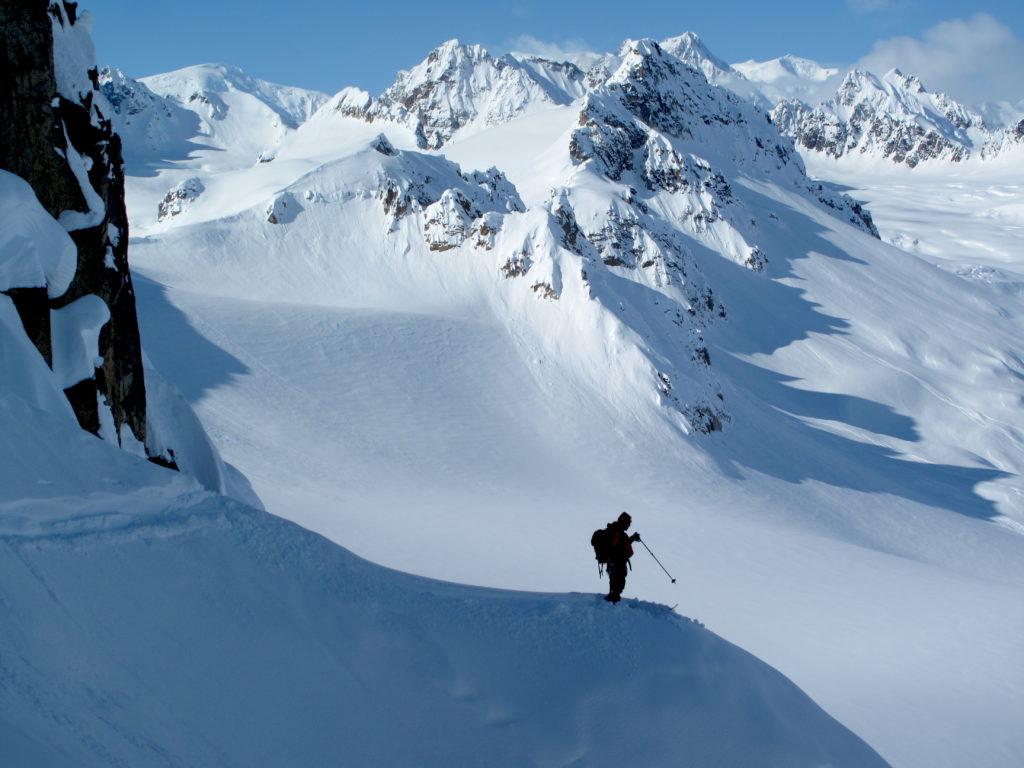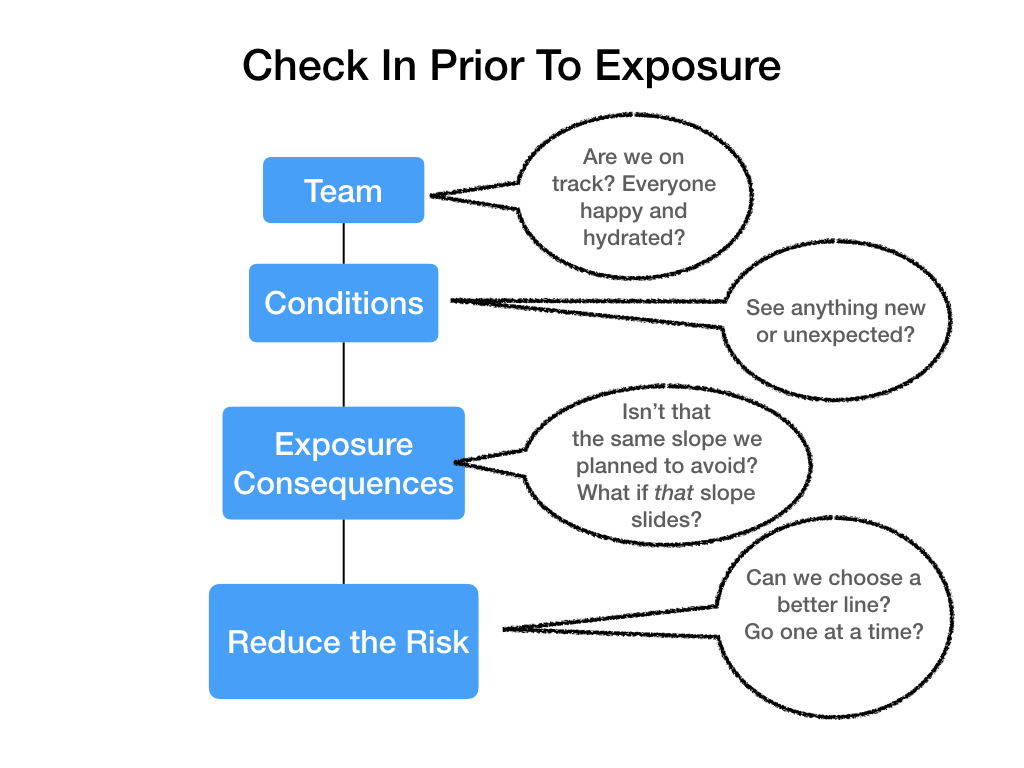Notes From a Pro: The Power of Noticing
When talking about avalanches, we understand the potential for danger. But there is a lot about snow that we don’t know. We make statements about snowpack structure, strength, and variability from just a few observations. We make assumptions about the likelihood of avalanches and their destructive potential. We have uncertainties. Yet, we travel in avalanche terrain and we take risks.
In the avalanche path there is a critical need to be observant—to coalesce observations into patterns and trends and reduce uncertainty as best as we can. To do this we need to accurately perceive our snowy environment. We must understand how weather, snow, and terrain combine to form avalanches. And we need to be able to foresee consequences when exposed to avalanche terrain. These last three factors lead to an awareness that supports quality decision making in avalanche terrain. The one certainty is that a loss of awareness—situational awareness—is the primary factor in accidents attributed to human error. None of us are immune to reduced awareness. We can be distracted or unobservant. My good friend Scott Davis, a longtime backcountry skier and mountain guide, calls our ability to perceive, to understand and foresee the avalanche risk, “the power of noticing.”
A bunch of years ago I argued to a pro avalanche class that “after 15 years in this business, we are barely good enough to do this job safely.” The quip resonated with the class. They recognized that it takes experience to verify field observations and determine relevancy. Students benefit from a mentorship that nurtures the ability to forecast avalanches, manage uncertainty, and cope with the consequences. However, experience isn’t everything. Apprentices make decisions within the scope of their experience. Good decision makers are aware of factors that reduce our perception of the environment. And students are quick to employ key decision-support tools that maintain awareness, promote reflection, highlight uncertainty and inexperience, and encourage terrain selection appropriate for the conditions. It can be as simple as a few questions that prompt a team check-in, a reassessment and adjustment, and a group decision.

Manage the Factors that Reduce Awareness
Wellness
Lack of fitness or sleep, pain, and illness are obvious factors that can contribute to reduced awareness and poor communication during trip planning and backcountry travel. And it’s always a struggle to talk about our mental health, addiction, or chronic physical health issues. Let’s be honest with our team. They will understand and want to tour with us anyways. Communicate your state of being and agree that if one person is not up to the complexities of the day then shorten the trip, choose simpler options, and avoid hazardous terrain. When possible get out and enjoy yourself—it may be cathartic. Recognize the importance of being warm, comfortable, astute and on top of your game when making decisions in avalanche terrain.
Fatigue
It’s a no-brainer: When we lose our power, we lose the power of noticing. Erratic pacing, dehydration, and hunger all add to fatigue. Arguably the effects of fatigue and dehydration are the No. 1 contributor to reduced field awareness. A steady pace between pre-planned check-in stops will maintain health and team communication.
Distraction
Perceiving danger requires focusing on the task at hand. Chatting, nibbling, texting, and posting images at the wrong time can distract you from seeing your environment. Use your phone in a safe location to navigate, review the backcountry forecast, and to capture observations worth discussing later. Then put the phone away. Watch and connect the dots. Focus on how you plan to manage the terrain. Too often our inattentive socializing compromises planned team spacing when crossing a steep slope. When we lose our focus we lose our ability to see danger clues and to argue a point. Speak up and ask, “Why we are following this old track into greater danger rather than exercising a safer option?”
Habit
Familiarity can be a good thing. You’ve been there and you know what worked. You have formed your preferences and know you can optimize fun. But habit can also dull your senses. You repeat the same trip. You conduct snowpack tests in the same place. And you make assumptions (“I’ve never seen that slope slide”), generalize patterns (“This valley always has more snow and no weak layers”), and adopt a confidence that stops you from searching for disconfirming evidence. When new to a region or drainage, you might in fact be safer. You have more incentive to research trip options and are more willing to dig and investigate weak layers. The unfamiliarity may mean you are more conservative with terrain choices because you are skiing everything for the first time. You are soaking in the new environment. The trick to foiling old habits is to look at familiar terrain with new eyes. Bring someone along who hasn’t been there before and encourage them to challenge your plan.
Embrace the Factors that Heighten Awareness
Fear and Anxiety
Fear is our natural response to a perceived threat. Anxiety can identify uncertainty with conditions and unfamiliar terrain. Either way, expressions of fear and anxiety warrant consideration and discussion. If one in the team voices fear or anxiety (that you or others don’t share), then this is your opportunity to define and not dismiss it. Clarify your thought process. Encourage a contrary opinion. Engage in dialogue and see if your thesis is supported by evidence and not assumption.
Team Check-In
Those who ski together decide together. Pre-planned stops or check-in points at key junctures along your route are critical to team decision making. While the group may have anticipated conditions and have a strategic route plan, safe travel requires a field reassessment of conditions and final consensus on terrain management. The straggler, last up the skin track into the regroup, may be the one person who saw the fresh avalanche on the wind loaded slope above. These example questions prompt reflection and promote discussion: “Are we on track? Everyone happy and hydrated? See anything new or unexpected? Isn’t that the same slope we planned to avoid? What if that slope avalanches? Should we go one at a time? Can we choose a better line and reduce the risk?” Questions and dialogue promote situational awareness. And consensus helps interrupt desire, bias, and old habits.

The team check-in employs reflective questions that maintain situational awareness and promote discussion, decisions, and error correction.
Consensus means more than one set of eyes, ears, and thoughts are contributing to a collective decision. Our perception of risk is only true to the extent that the right facts are connected to the right circumstances. Our collective wisdom is required for that task.
Curiosity
Be curious. It feeds the power of noticing. Here are some examples of the dialog you should be engaging in.
- Maybe if I skin up to that bump, I’ll get a better look at the slope we plan to ski.
- I think I’m going to take five minutes to see if I can dig down to the weak layer the advisory was talking about. I want to take a closer look.
- Doesn’t that slope above us have the same aspect and elevation as those paths the backcountry forecast warned us to avoid?
- Check it out, we are getting a break in the weather. Let’s stop for five minutes to see if we might get a better view of our line.
Support the inquisitive one in the group. It’s likely they have the intuitive response that also contributes to good decision making.
The Love of the Game
Heading off on an adventure with our eyes wide open means we head out the door knowing what we are getting into. We know the obstacles, the challenges, and the risk. And we got the love of the game. Infectious enthusiasm doesn’t mean we are blinded by the thrill. Quite the opposite. Our passion for ski touring means that when we stick on the skins and start striding forward, we are in the moment. The long uphill walk can be an intensely private time to meditate on the team, the weather, the snow, the terrain, and the risk. We can channel this into being hyper observant and thoughtful. We watch how the sun moves across the sky and notice how the wind fills in old tracks and changes the snow surface. We memorize every feature on every slope. Our mind’s eye moves us through the terrain and plays out scenarios—we imagine those what-ifs… It’s our love of the winter backcountry that improves our skills, develops knowledge, and breeds success.
Maintaining Perception
Our power of noticing is our ability to maintain an accurate perception of environmental elements and events—our awareness of our situation. We have reviewed factors that challenge or reduce our perception and understanding. And we have discussed factors and promoted use of reflective questions and team check-ins that can heighten awareness in the backcountry. Our power of noticing lays down the foundation for successful decision making across a broad range of situations. Our perception helps us identify the hazard and the potential of the terrain. Our understanding helps us analyze those factors and aggregate information into patterns and trends and to target uncertainties. And it’s our ability to anticipate consequences that allows us to see the potential for harm. Our foresight helps us create options, evaluate the risk, and select and manage terrain. Ultimately it’s this awareness, our focused attention, that puts the risk in perspective and allows us to relax and enjoy our wintery world.
Colin Zacharias is a consultant and educator in the avalanche and mountain guiding industries, and an IFMGA/ACMG mountain guide. He resides on Vancouver Island.


